‘Inception’ at 15: How I Faked Sick for Christopher Nolan—and Learned to Love the Bomb
Nolan’s films suggest spectacle and intellect don’t have to be at odds. Fifteen years later, I revisit the one that made me believe it.
July 2010. I took an emergency leave from work to catch Inception in theaters, then on the tail end of its first week. I hadn’t seen it on opening day or during its opening weekend. Not that I intended to, by the way—back then, I wasn’t a cinephile, much less someone who regularly wrote about movies.
All I knew was this: it was directed by the same guy who made Batman Begins and The Dark Knight. Those were films I appreciated, but hadn’t quite loved. Maybe because I was still used to lighter, more cartoonish superhero fare. Or maybe because I hadn’t really sunk my teeth into the magic of cinema at the time. At least not yet.
Still, the director intrigued me. Even then, he already felt like a name to watch—a brand, not unlike the studios that distributed his work. That was enough for me to fake an illness, call in sick, and make a mad dash to the nearest theater.
What happened next was something I didn’t expect. Cities folded in on themselves, gravity twisted down hallways like a Mobius strip, and a musical score pounding through me like a countdown to apocalypse. But more than the mechanics, it was the idea that knocked me sideways: that a movie this massive, this expensive, could also feel this deliberate. It was the first time I understood that a blockbuster could be a work of art—not in a sheepish, post-hoc justification sort of way, but because it was designed to be both.
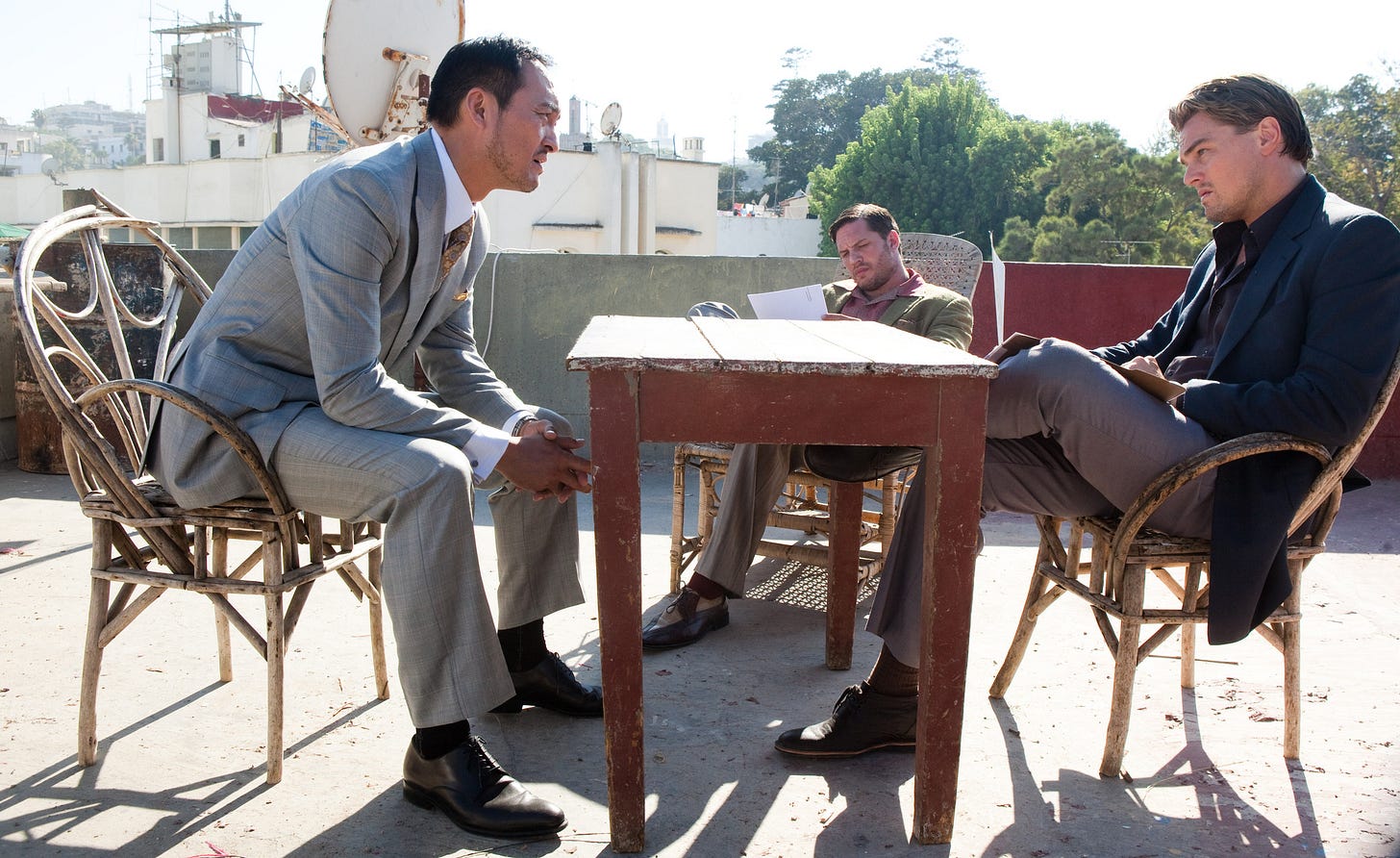
The [Dream] Job of a Lifetime
At this point, Christopher Nolan had already been ascending: Memento was the puzzle that made everyone curious, The Prestige proved he had more than tricks up his sleeve, and The Dark Knight redefined what a comic book movie could be. But Inception was something else entirely. Here was a studio backing an original script—no franchise, no comic book, no existing brand—to the tune of $160 million.
That it even exists feels improbable. And that it’s this good is nearly unthinkable.
On paper, it reads like a sci-fi high-wire act: Dom Cobb (Leonardo DiCaprio), a thief for hire who extracts secrets from people’s subconscious during shared dream states, is hired to do the inverse—plant an idea instead. This idea, the eponymous "inception," must penetrate multiple layers of dreaming, requiring a team, a plan, and a willingness to bend perception and physics along the way. But what makes the premise work is that the heist structure is not merely a narrative hook; it’s a map for how Nolan folds theme, emotion, and exposition into one another.
The job comes from Saito (Ken Watanabe), a powerful executive who wants Cobb and his team to convince the heir of a rival energy conglomerate, Robert Fischer (Cillian Murphy), to dissolve his father's empire. The mission is to journey three levels deep into Fischer's subconscious—each dream within a dream more unstable than the last. To pull it off, Cobb assembles a team: Arthur (Joseph Gordon-Levitt), his methodical point man; Ariadne (Elliot Page), a gifted architecture student tasked with designing the dreams; Eames (Tom Hardy), a forger who can manipulate identity within the dream space; and Yusuf (Dileep Rao), the chemist needed to knock everyone out long enough to operate within multiple temporal layers.
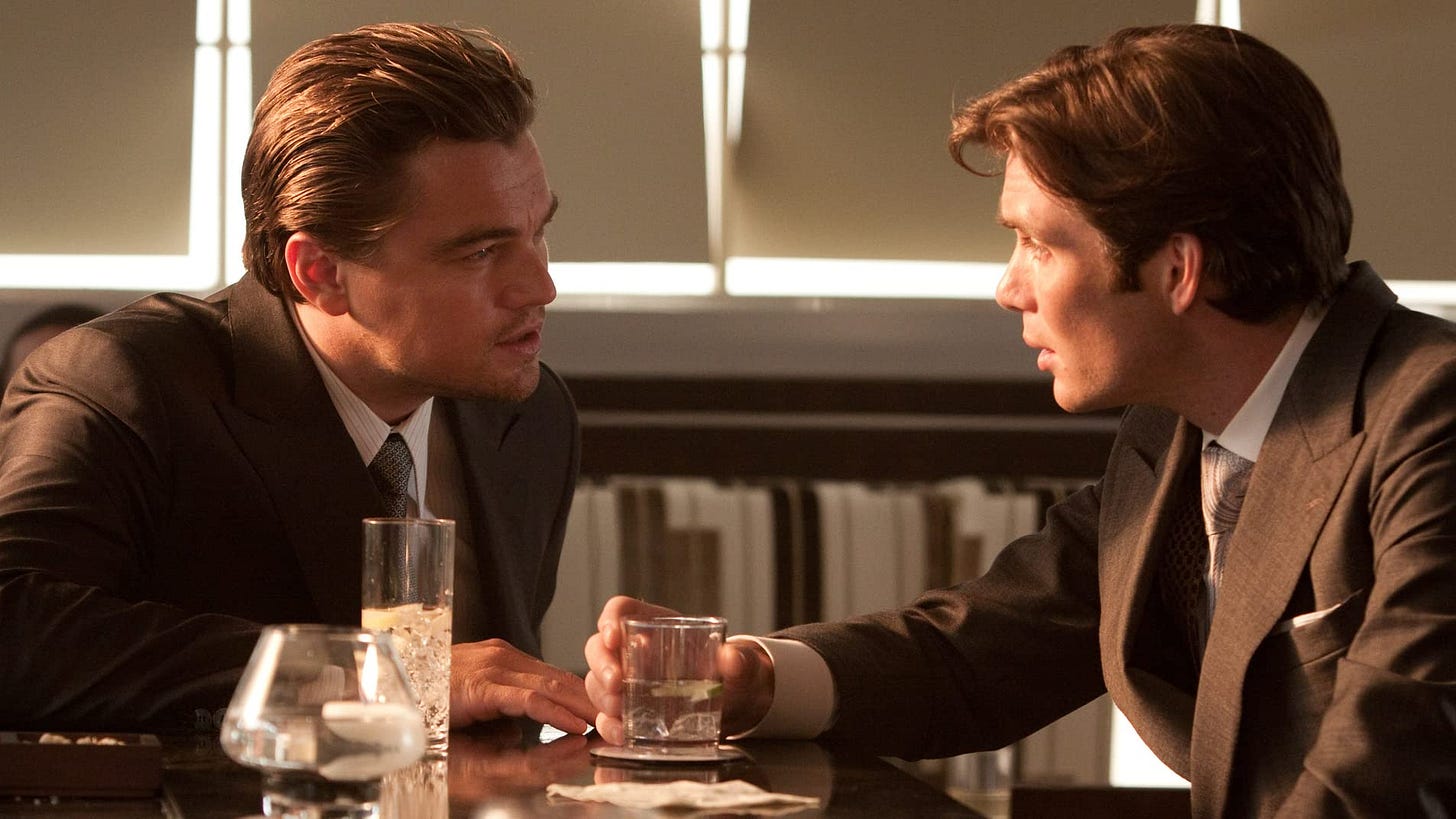
The Heist Between Dreams
Nolan frames the entire film like a classic caper: planning, team assembly, reconnaissance, execution, and complications. The complications, of course, are uniquely psychological. Cobb’s subconscious, in particular, has been compromised by projections of his dead wife, Mal (Marion Cotillard), whose spectral presence repeatedly sabotages the mission. These aren’t ghosts, but instead Cobb’s own guilt in corporeal form. Mal basically serves as emotional trauma rendered as interference. It’s here that Nolan collapses the heist genre into something closer to psychoanalysis.
Each dream level has its own genre flavor: the rain-slicked city streets of the first level unfold like a car chase in a modern thriller; the second, a sleek hotel corridor where gravity becomes fluid, plays like a Hitchcockian noir set piece; the third, a snowy fortress under siege, evokes the wintry spectacle of a James Bond film.
Beneath all of it runs a ticking-clock mechanic: time stretches the deeper they go, with five minutes in the real world equating to an hour, a week, or more in the dream world below. And then there’s Limbo—a raw subconscious terrain where dreamers can become lost, indefinitely.
Nolan, the Emotional Logician
But for all its dazzling structure, Inception’s emotional spine remains Cobb’s arc. He is not merely running from the law (he’s accused of killing Mal) but from himself. Mal exists in his mind as both memory and saboteur, forcing Cobb to relive her death again and again. He must confront her in Limbo and let her go, a metaphor for grief if ever there was one. The idea he must plant in Fischer’s mind becomes a mirror for the catharsis he denies himself: that letting go is not defeat, but release.
This emotional throughline is what elevates Inception above the level of puzzle-box filmmaking. Yes, it’s a maze, but it’s a maze built to contain pain, and then to navigate through it. The dream logic is airtight, but it’s the emotional logic that resonates. What is the point of a perfectly executed idea if it can’t undo the brokenness within you? What if Cobb’s entire pursuit of the job isn’t about redemption, but about buying his way back into reality through one last perfectly designed illusion?
And maybe that’s what makes Inception so thrilling fifteen years on: it invites you into its logic. Nolan doesn’t hold your hand, but he builds a staircase and dares you to climb it. The narrative is a self-justifying riddle, one where form is meaning, and structure is story. The dreams aren’t just spaces for action—they're emotional vaults, psychological terrain made visible.
Related Essay: ‘Interstellar’ at 10: A Closer Look at a Filmmaker’s Love Letter to Exploration, Family, and Humanity
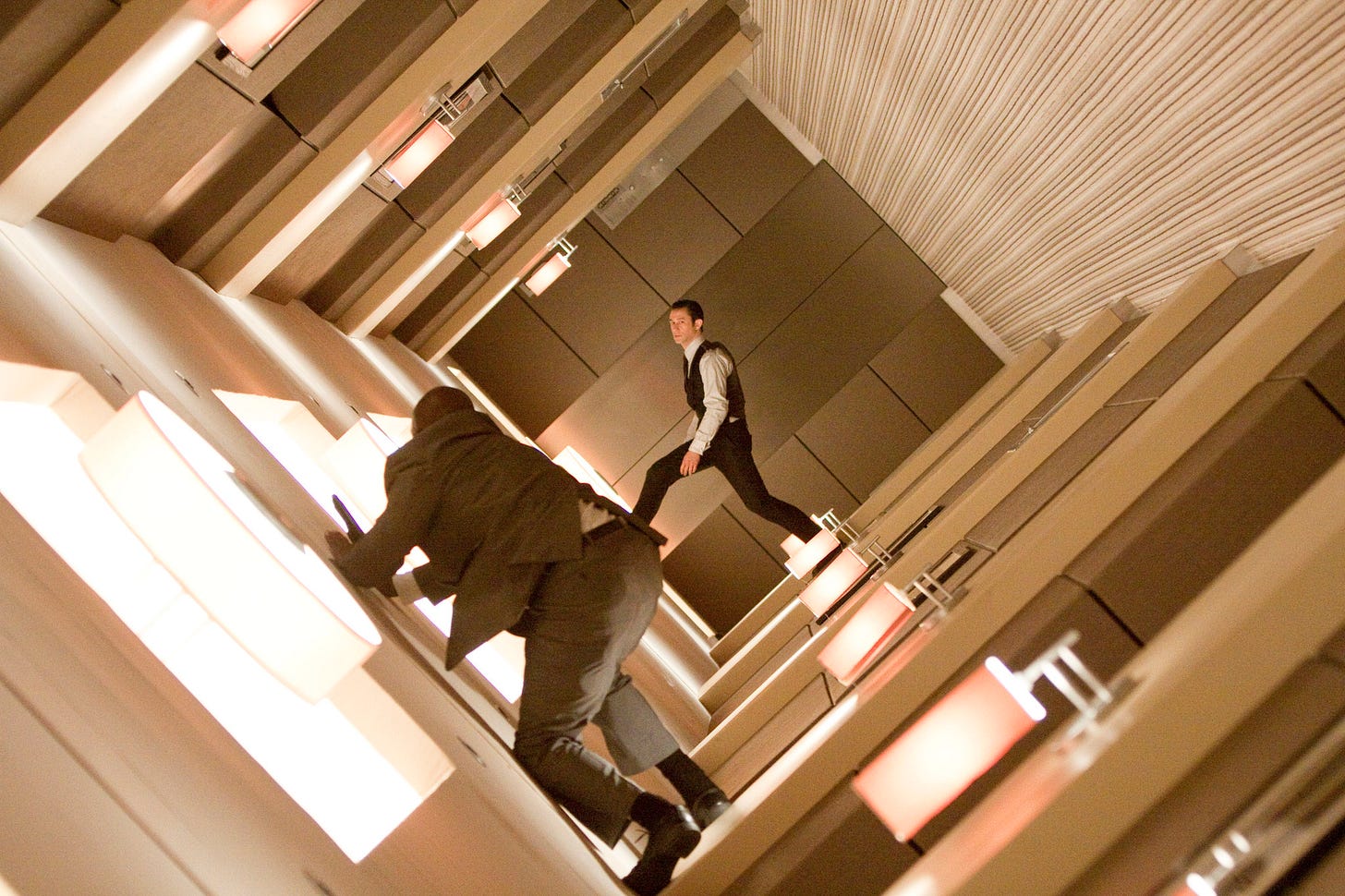
Practical Surrealism
Most films fade with time. The special effects age, the references date, the dialogue stiffens. Inception hasn’t. It still dazzles, and it does so because so much of it was done in camera. The zero-gravity hallway sequence, where Gordon-Levitt bounces off walls in a dream-space devoid of physics, was shot inside a rotating set. The Parisian street café, where Ariadne (Page) realizes they’re dreaming as the environment explodes around them in slow motion, plays like a visual sonnet.
And then there’s the snow fortress—a Bond homage filtered through dream logic—executed like a third-act war film with muscle and texture. (Specifically, On Her Majesty’s Secret Service, a film Nolan has often cited as one of his all-time favorites.)
Wally Pfister’s cinematography brings all of this together with a muted elegance that mirrors Nolan’s usual palette. This was Pfister’s penultimate collaboration with Nolan, having worked with him since Memento. His work here captures the shifting tone and geography of each dream level, from the rainy cityscapes to the clean, Escher-like hotel interiors and the crisp, icy whites of the mountain fortress. Each layer feels distinct, yet part of a coherent whole. It’s a feat of visual storytelling that doesn’t just complement Nolan’s vision; it elevates it.
Pfister’s eye was so crucial to the tactile, grounded aesthetic of Nolan’s early career that it’s no surprise he would soon trade cinematography for directing. After all, how do you top this?
Bravura Editing and Scoring Serve a Multilayered Story
And then there’s Lee Smith, the editor who keeps all the plates spinning. A story this multilayered—dream levels running concurrently, each with its own time logic—should be disorienting. But Smith’s bravura editing finds clarity in complexity. The cross-cutting between levels during the third act—the van falling into the river, the elevator timing for the kick, the skirmish in the snow, and Cobb’s confrontation with Mal in Limbo—should be chaotic. Instead, it’s symphonic.
This is what makes Inception rewatchable, not in a puzzle-solving sense, but in an “admiring the construction” sense. You rewatch it not because it confused you (though it may have), but because it awes you. (This is me talking to you, Mr. Nolan: Tenet was the one that confused the hell out of us.)
Just like with all of his films, the filmmaker used little computer-generated imagery, instead preferring practical effects whenever possible. Nolan’s aversion to CGI wasn’t just stylistic; it was philosophical. He wanted these spaces to feel real because dreams, paradoxically, do. He understood that the uncanny is more powerful when it’s grounded, when the seams are harder to see. At a time when blockbusters were becoming green-screen parades, Inception argued for the old ways: models, sets, stunts, you know. Craft.
And yet it wasn’t just the visuals. The score—Hans Zimmer’s now-iconic foghorn of dread, the BWAAAM that launched a thousand trailers—was revolutionary. Its DNA is still inescapable. Every other trailer for the next decade borrowed its structure: a whisper, then a swell, then the thud. What Nolan and Zimmer created wasn’t just a soundtrack; it was a new cinematic cadence. The sound design was so tied to the film’s conceptual backbone that even its tempo echoed the use of Edith Piaf’s "Non, je ne regrette rien," stretched and slowed to match the altered experience of time in dreams.
The Emotion Buried in the Blueprint
Still, the film had its skeptics when Inception came out. In fact, it still has to this day. Even among fans, you’ll hear familiar refrains: too much exposition, characters as chess pieces, too cerebral to be moving.
And I’ll admit it—there are moments where Inception shows the limitations of Nolan’s storytelling instincts. The most glaring for me comes in what could have been DiCaprio’s emotional apex: the moment Cobb watches Mal leap from a hotel window, a memory looped by guilt. It should be unbearable. But the camera doesn’t linger. There’s no raw close-up, no shattered breakdown. Nolan pulls away just as DiCaprio seems ready to tear through the screen.
It’s frustrating because I will argue that it could have deepened the film’s emotional reservoir. DiCaprio, more than capable of volcanic intensity, is restrained here, hemmed in by a director more interested in architecture than catharsis. If we had lingered—if we had stayed—Cobb’s guilt might have landed harder. His yearning to see his children again would carry even more weight.
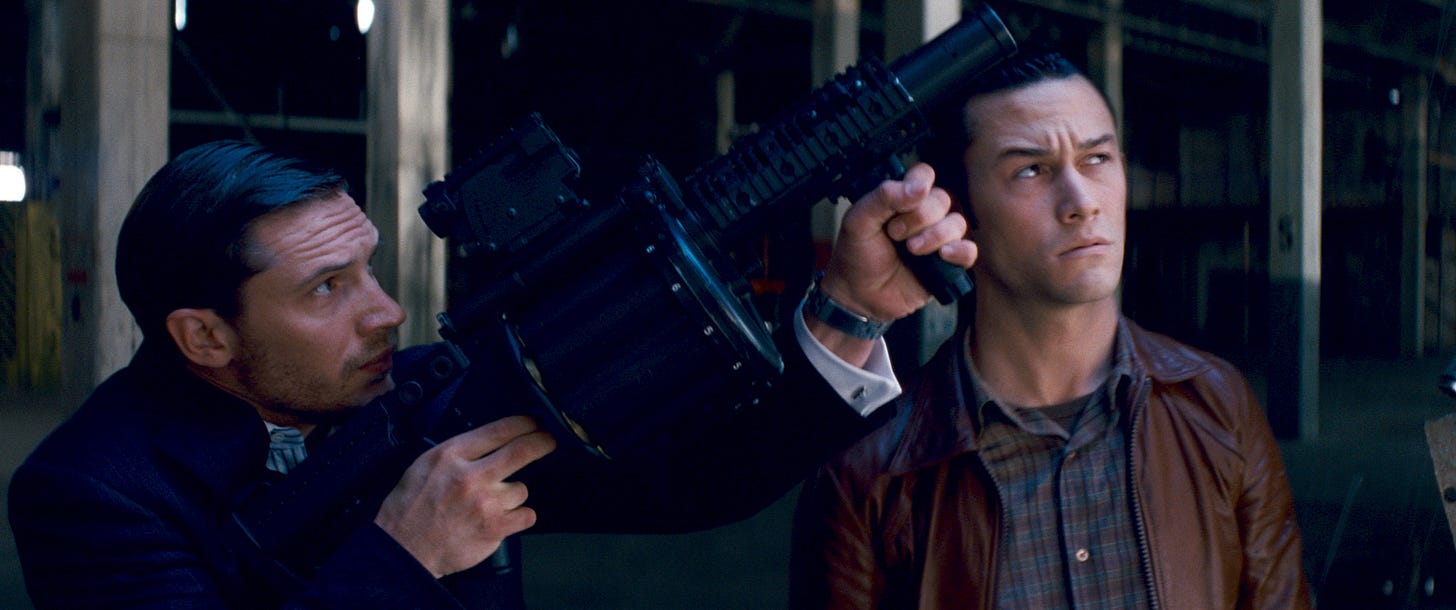
Mal, too, would’ve emerged as more than just a figment of memory. For all of Cotillard’s ghostly grace, Mal often registers as a device rather than a person. She’s technically a projection of Cobb’s subconscious, yes—but the brevity of their dramatic scenes makes their shared past feel more conceptual than lived-in. With just a few more scenes of honest, emotional excavation, their bond could’ve carried greater poignancy. As it stands, she’s the idea of guilt given form, rather than a fully dimensional character we can grieve alongside Cobb.
Even so, I don’t believe that means the film is emotionally empty. It’s simply buried. Cobb is repressed, compartmentalized, trying to outbuild his pain. The emotional logic of the film mirrors the dream levels: the deeper you go, the more volatile it gets. Ariadne is our guide into Cobb’s subconscious, and what she finds isn’t some abstract meditation—it’s grief, weaponized. And when Cobb finally lets go, choosing reality over projection, that’s not a cold decision. It’s a quiet devastation.
‘Inception’: The Legacy Beyond the Meme
Filmmakers usually never set out to make cultural phenomena with their movies, and Nolan is no exception. But Inception became one anyway. It gave us a shorthand for complexity (“It’s like Inception, but with dreams inside dreams...”), and an ending that launched a million debates. The spinning top wasn’t just a trick—it was a litmus test. What you saw said something about you. And few films of that decade achieved that kind of resonance.
Over the years, it’s also become something else: a touchstone for movie lovers, meme-makers, and pop culture at large. The term “inception” has entered the lexicon. It’s referenced in sitcoms, parodied in sketch shows, and cited as the ultimate metaphor for nested systems, corporate jargon, and self-aware storytelling. In a way, it’s become both a symbol and symptom of our era’s obsession with layers: of meaning, of media, of manipulation.
And then there’s the impact of its sound. Hans Zimmer’s BWAAAM wasn’t just a musical cue; it was a cultural event. Case in point: trailers haven’t been the same since. The lull-thud rhythm, the elastic pacing of silence and impact—nearly every blockbuster since has tried to capture that same dread-laced anticipation. The score seeped into the visual language of cinema, where sound itself became narrative propulsion.
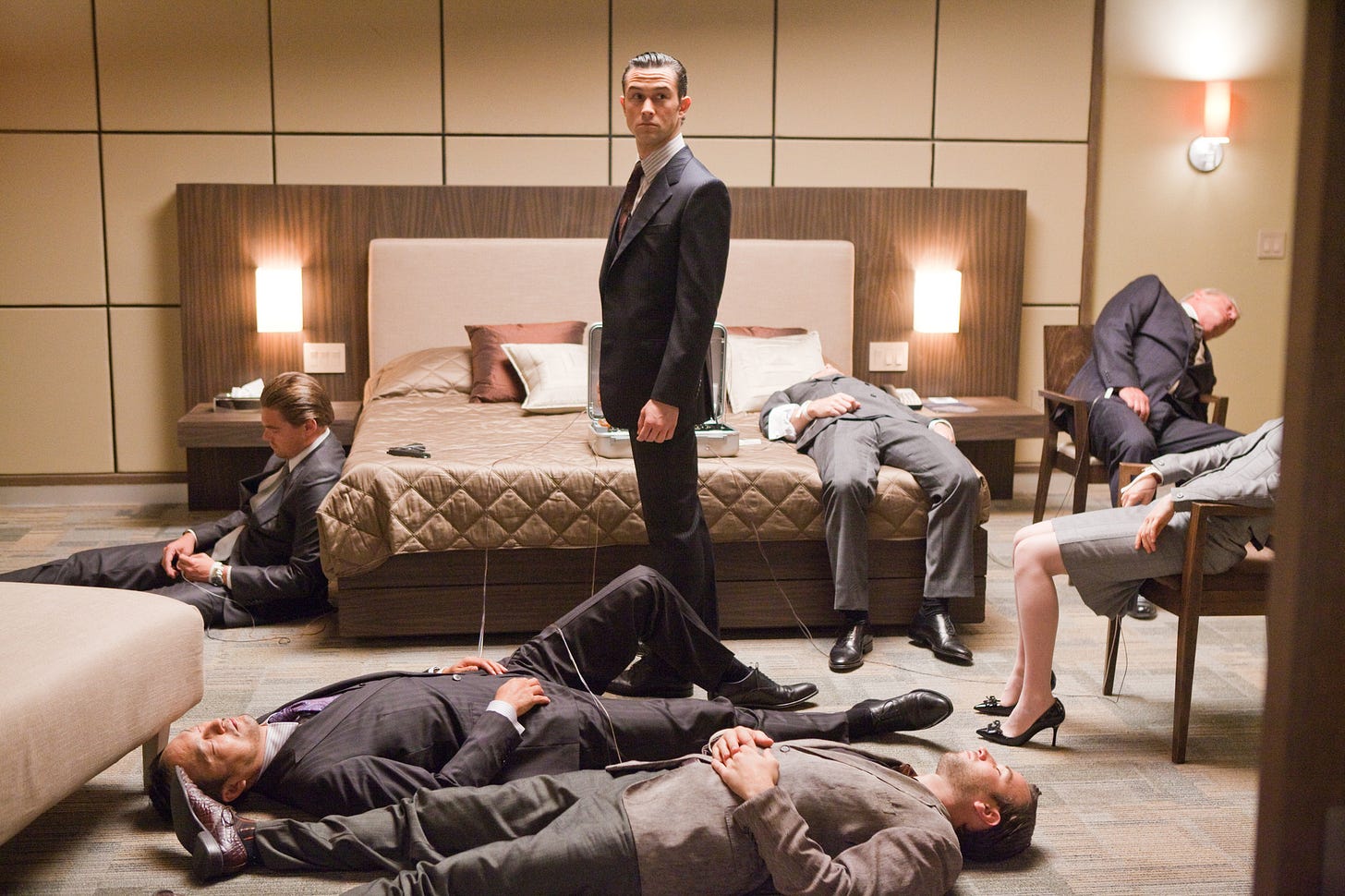
Does it hold up next to the critical darlings of its time? Absolutely. Personally, I feel that if there’s one film from 2010 that stands shoulder-to-shoulder with Inception, it’s The Social Network. David Fincher’s film is sharper in its social critique, more restrained in its aesthetics, and timelier in ways Inception never aimed to be. Even so, Inception isn’t interested in being “about” 2010. Its design is mythic, psychological, and cyclical. That’s why it’s still being referenced, memed, parodied, and written about. That’s why it endures.
In the digital age, Inception has done something extraordinary: it hasn’t just remained relevant—it’s evolved. It still inspires Reddit threads, academic essays, and Twitter debates. It has taught audiences how to watch complicated stories without handholding. It proved that ambition could be mainstream. And that yes, a movie could be many things at once: big, bold, meticulous, moving…and wildly entertaining.
The Kubrick Conversation
It was inevitable, I suppose, that critics would start lobbing Stanley Kubrick comparisons, especially at the heels of Inception’s release. A cerebral filmmaker with an obsession for precision? Check. Thematic ambition wrapped in genre trappings? Check. But the truth is, those comparisons say more about our need to label than they do about Nolan’s work.
Yes, you can trace the elevator hallway to The Shining. The clean geometry of Inception, the obsession with space and time, the chilly modernist architecture—they all feel like pastiches of Kubrick’s design sensibilities. Nolan, like Kubrick, believes in world-building down to the floor tile. He cares about rhythm and clarity, symmetry and silence. But there’s a difference in posture. Kubrick observes; Nolan invites. Kubrick presents us with enigmatic riddles and rarely grants emotional access; Nolan builds enigmas but then plants characters inside them and asks us to care.
That might explain why Nolan’s films, especially Inception, are sometimes derided as being “all head, no heart.” Kubrick’s remove is admired as brilliance. Nolan’s restraint is seen as a flaw. But I think that’s misreading the emotional grammar of Nolan’s style. Where Kubrick cools down, Nolan bottles up. The emotions are there—buried under layers of design and guilt and ticking clocks—but they still throb.
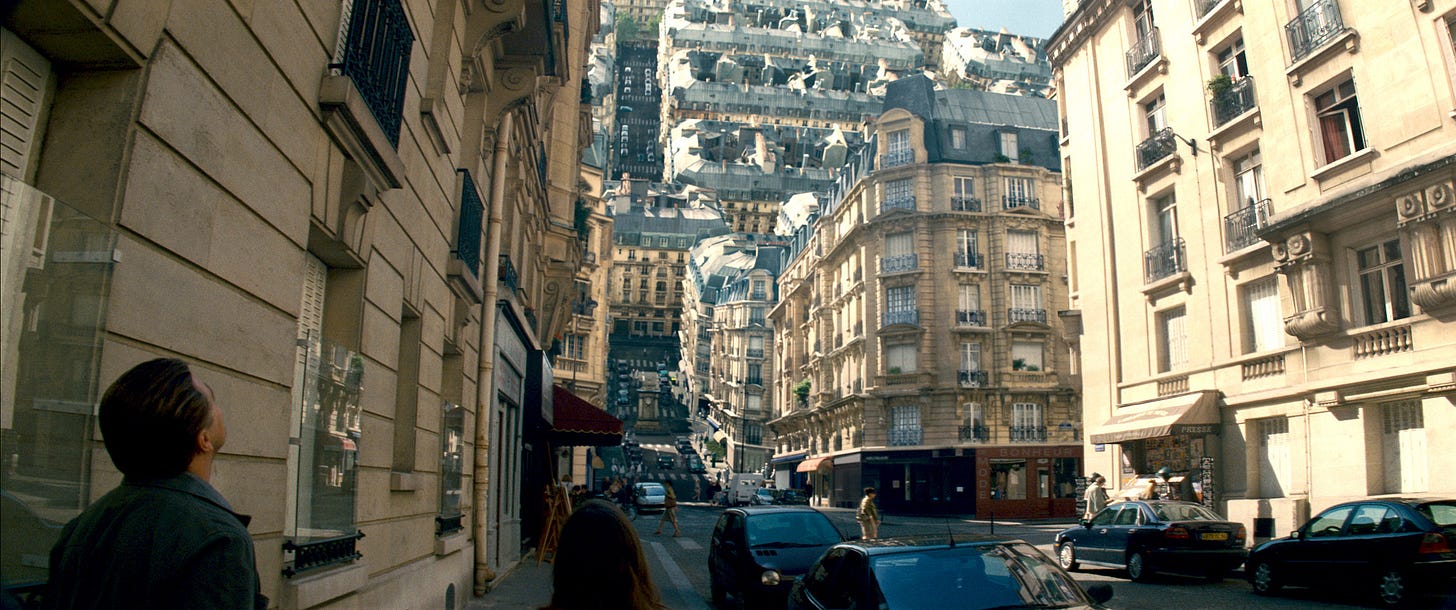
The Other Non-Kubrick Inspirations of ‘Inception’
More revealing than the Kubrick comparison, though, is where Nolan does pull from. The Bond homage in the snow-covered fortress isn’t just a flourish; it’s Nolan honoring On Her Majesty’s Secret Service, a film whose tragic weight and kinetic style clearly impacted him. The dreamy architecture and looping structures also gesture toward Alain Resnais’ Last Year at Marienbad, with its recursive logic and hypnotic displacement. Even Alfred Hitchcock leaves fingerprints on Inception: the high-angle surveillance shots, the cascading reveals, the psychological MacGuffin.
What Inception really does is mark Nolan’s passage from homage to authorship. His previous work paid tribute in ways both subtle and overt—The Prestige riffed on Victorian thrillers and magician tropes; Batman Begins borrowed noir structure with a hero’s-journey backbone. But Inception is different. It is a self-enclosed thesis on what Nolan values: structure, tension, emotional repression, and cinematic architecture.
It’s also the moment Nolan stopped being a promising talent and became, for better or worse, a reference point. Post-Inception, his name alone could greenlight a blockbuster. That’s an incredibly rare shift. And it happened not with a sequel or an IP adaptation, but with an original script built on dreams and doubt. From here, Nolan would go bolder and more abstract (Interstellar), more minimal and fragmented (Dunkirk), more confounding (Tenet), and finally, historical and devastating (Oppenheimer). But Inception was the launch pad. The prototype. The one that taught studios—and audiences—that intellect and immersion weren’t mutually exclusive.
So is he the next Kubrick? The comparison is fun, but maybe beside the point. Kubrick wasn’t trying to be anyone else. Neither is Nolan. They just share a devotion to the form—celluloid architects with different blueprints.
On Being My First Personal Favorite Blockbuster
I still revisit Inception regularly, but not out of nostalgia. Instead, I re-watch how it moves in ways few blockbusters dare to. It’s rigorous but not alienating. Ambitious but not pretentious. Its world is contained, yet it unfolds endlessly in the mind. Watching it again now, I’m struck by how whole it feels—how it refuses to date itself by tying to trends, and how it still manages to feel audacious in an age where originality is the riskiest thing a filmmaker can do.
I think back to July 2010, that midweek afternoon when I faked an illness and ran to the nearest theater. I wasn’t a critic then; I wasn’t even what I’d now call a cinephile. All I knew was that this was a new film from the same guy who made The Dark Knight, and I didn’t want to miss it before it vanished from theaters, as so many films do in my home country. I remember sitting in that darkened room, heart pounding with each bass-thudding fold of cityscape and every ticking second of Zimmer’s war drum masquerading as a score. And I remember walking out with more questions than answers—but energized by the questions themselves.
Inception didn’t just show me what cinema could do. It reoriented what I expected movies should do. It was the first time I saw that the so-called divide between art and entertainment wasn’t a wall—it was a revolving door. And Nolan had nudged me through.
Revisiting the Spinning Top, Fifteen Years Later
Over the next several years, I’ve since seen many more films. Federico Fellini and Andrei Tarkovsky, Claire Denis and David Lynch. I’ve become more patient with ambiguity, more aware of form. But I always return to Inception not just because of what it is, but because of what it unlocked in me. It was a spark, a gateway drug, a cinematic Rosetta Stone that told me: you can love movies for how they make you feel, and also for how they’re built.
Fifteen years later, I still don’t care whether the top falls. That was never the point. What matters is that Nolan trusted the audience enough to ask the question; and that I, along with millions of others, wanted to chase the answer. That’s not just smart filmmaking. That’s a kind of faith. And in this world, maybe the boldest thing a movie can do is leave you wondering—willingly, excitedly—what it meant to you.
All I knew that day was I wanted to see a movie. What I found was the kind of revelation that sneaks up on you: a film bold enough to plant a thought, and patient enough to let it grow.






